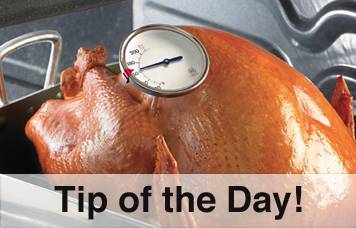Take the Stress Out of Preparing the Perfect Turkey
TEXARKANA, Ark. –
As Thanksgiving approaches, we want the star of the show to be the turkey. There is no need to stress about preparing the perfect turkey. With just a little know how, you can prepare a stress-free turkey.
One of the first decisions to make is will the bird be fresh or frozen. If you choose a frozen bird you may do so at any time. Make sure, though, that you have adequate storage space in your freezer. With a frozen turkey you will need to remember thawing times. The safest method is to thaw turkey in the refrigerator. Plan ahead; it takes approximately 24 hours per 5 pounds of turkey to fully defrost.
If buying a fresh turkey, purchase only 1-2 days before cooking and never buy a pre-stuffed fresh turkey, because it allows bacteria to possibly spread easily from the bird to the stuffing. Instead, buy a fresh turkey and stuff it yourself.
Cooking times will differ depending upon fresh or frozen. Plan on 20 minutes per pound in a 325 degree oven for a defrosted turkey and 10 to 15 minutes per pound for a fresh turkey.
Before you begin roasting, coat the outside of the turkey with vegetable or olive oil, season with salt and pepper and tightly cover the breast with aluminum foil to prevent over-browning. Once you get the turkey in the oven, resist the temptation to open the oven door. When the oven temperature fluctuates, you're only increasing the likelihood of a dry bird. About 45 minutes before the turkey is done, remove the foil from the breast to allow it to brown.
Use a food thermometer to check the internal temperature of the turkey and assure a moist bird. A whole turkey is safe when cooked to a minimum internal temperature of 165 °F throughout the bird. Check the temperature in the innermost part of the thigh and wing and the thickest part of the breast. All turkey meat, including any that remains pink, is safe to eat as soon as all parts reach at least 165 °F.
When the turkey is removed from the oven, let it stand 20 minutes. I know this might be hard, but it will allow the juices to seep back into the bird, yielding a moist bird. Take this time to finish up the meal.
Storing leftovers properly is just as important as cooking the bird properly. Cut your turkey into small pieces and place in shallow containers within 2 hours of cooking. Use leftover turkey within 3-4 days; gravy within 1-2 days; or freeze these foods. Reheat thoroughly to a temperature of 165 °F or until hot and steaming.
If you would like to receive more information, contact the University of Arkansas Division of AG in Miller County at 400 Laurel Suite 215 in Texarkana, call 870-779-3609, or e-mail me at chadley@uada.edu. You can also get great recipes and tips at facebook.com/millercountyfcs or twitter @MillerCountyFCS
Here is my grandmothers’ recipe for Perfect Roast Turkey. Hers came out perfect every time and was always delicious.
Grandma’s Perfect Roast Turkey
1 whole turkey
1/2 cup unsalted butter, softened
Salt and pepper to taste
1 1/2 quarts turkey or chicken stock
Preheat oven to 325 degrees. Place rack in lowest position in the oven. Remove turkey neck and giblets and set aside for gravy. Place the turkey, breast side up, on a rack in the roasting pan. Rub the skin with softened butter and season with salt and pepper. Make a tent over the bird with aluminum foil. Place in oven and pour 2 cups stock in the bottom of roasting pan. Baste all over every 30 minutes with the juices from the bottom of the pan. As dripping evaporates, add more stock, 1 cup at a time. After two and one half hours, remove foil. Roast until meat thermometer inserted in thickest part of thigh, away from the bone, registers 165 degrees on meat thermometer. Transfer to large serving platter and let stand for at least 20 minutes before carving.
Tried and True Tip:
Remember to carve your turkey with a very sharp or electric knife.
By Carla Haley-Hadley
County Extension Agent - FCS
The Cooperative Extension Service
U of A System Division of Agriculture
Media Contact: Carla Haley-Hadley
County Extension Agent - FCS
U of A Division of Agriculture
Cooperative Extension Service
400 Laurel Street, Suite 215 Texarkana AR 71854
(870) 779-3609
chaley@uada.edu
Related Links
The Arkansas Cooperative Extension Service is an equal opportunity institution. If
you require a reasonable accommodation to participate or need materials in another
format, please contact your County Extension office (or other appropriate office)
as soon as possible. Dial 711 for Arkansas Relay.
Pursuant to 7 CFR § 15.3, the University of Arkansas System Division of Agriculture
offers all its Extension and Research programs and services (including employment)
without regard to race, color, sex, national origin, religion, age, disability, marital
or veteran status, genetic information, sexual preference, pregnancy or any other
legally protected status, and is an equal opportunity institution.
